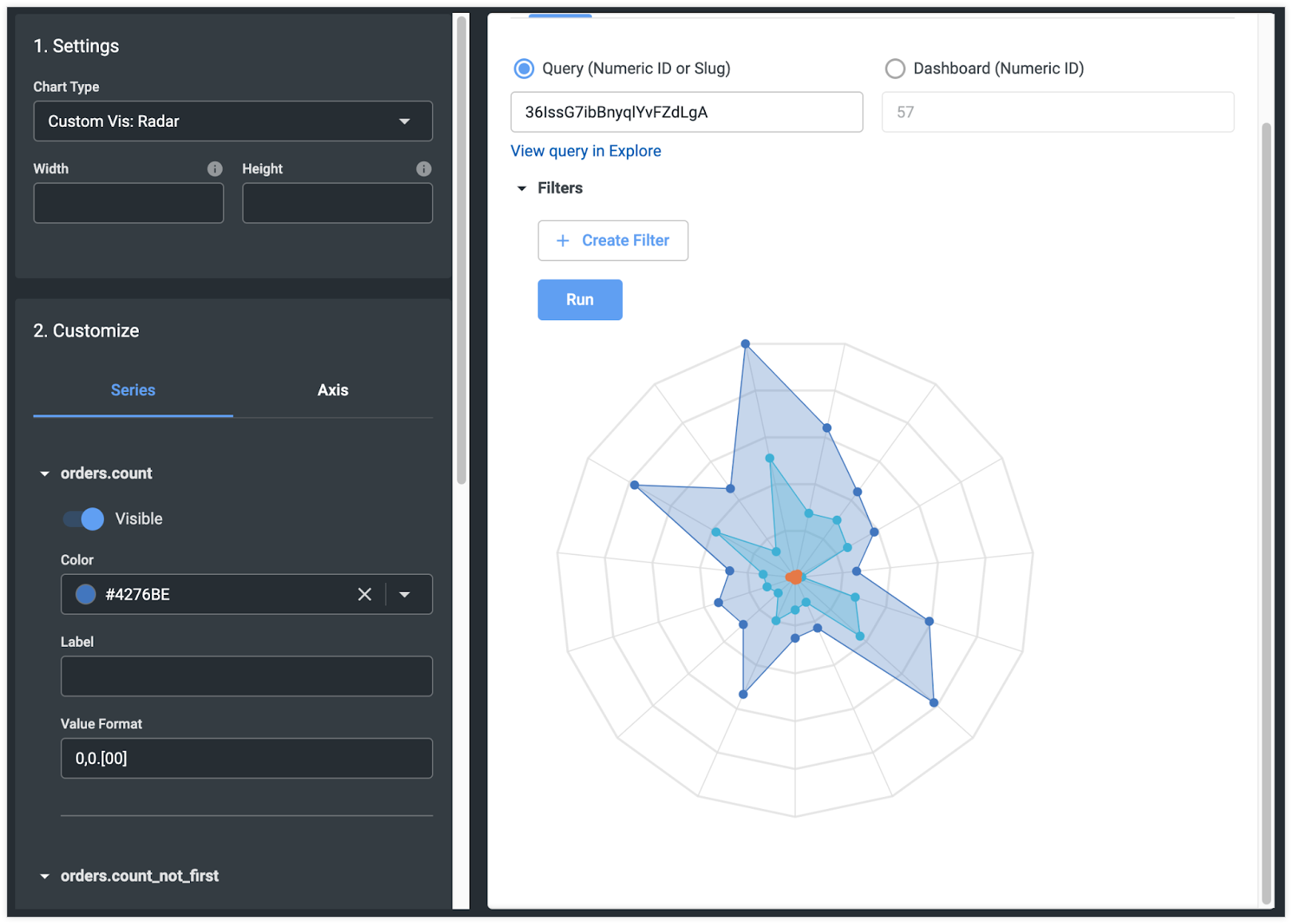This example renders a custom visualization that is local to an app being developed, not a custom visualization that is available from the Looker Marketplace.
Looker visualization components have an adapter system that allows developers to override existing chart types or add entirely new chart type options.
This option can be useful in the following circumstances:
- You have built custom React visualizations that you'd like to use with Looker components.
- You want to replace an existing default Looker visualization with a visualization that is built on a different library.
The ability to override or add charts can be especially relevant if you're building an application that allows users to change the type of chart visualization during a session.
Background
After rendering a query in Looker's Explore interface and passing its Query.client_id into Looker's visualization components, you can modify the chart type by updating the config property's type property.
Each value accepted by the type property is mapped to a specific React component. So, when type is set to line, a Line component is rendered; when type is set to area, an Area component is rendered; and so on.
The chartTypeMap property of the Visualization component allows you to add a new entry to, or replace existing entries in, the type/component map that associates each type value with a particular component.
Requirements
Similar to the Using visualization components and the query property to render a simple visualization example, you must begin by importing the DataProvider component and providing an authenticated SDK instance. The following example is built within Looker's extension
framework, and the SDK comes from ExtensionContext.
Within DataProvider, you can render the Query and Visualization
components to request data from the Looker SDK and render the expected visualization within your application.
The setup is as follows (in the query property, replace the value with the Query.client_id from your query):
import React, { useContext } from 'react'
import { ExtensionContext } from '@looker/extension-sdk-react'
import { DataProvider } from '@looker/components-data'
import { Query, Visualization } from '@looker/visualizations'
const App = () => {
const { core40SDK } = useContext(ExtensionContext)
return (
<DataProvider sdk={core40SDK}>
<Query query="z8klgi4PJKAl7TXgTw1opS">
<Visualization />
</Query>
</DataProvider>
)
}
Adding a new chart type
As with the simple visualization example, you can modify the rendered chart type by passing a config override to the Query component.
<Query query="z8klgi4PJKAl7TXgTw1opS" config={{ type: 'pie' }}>
<Visualization />
</Query>
In this case, type was set to pie: a chart that Looker components offer by default. But what if you would like to use a chart that isn't offered by default? In that situation, you can use the chartTypeMap property of Visualization to add or replace the chart components in the type/component map in the adapter system.
If, for example, you want to add a new radar chart to the type/component map, add it to the chartTypeMap like this:
import React, { useContext } from 'react'
import { ExtensionContext } from '@looker/extension-sdk-react'
import { DataProvider } from '@looker/components-data'
import { Query, Visualization } from '@looker/visualizations'
import { MyCustomRadar } from '../MyCustomRadar'
const App = () => {
const { core40SDK } = useContext(ExtensionContext)
return (
<DataProvider sdk={core40SDK}>
<Query query="z8klgi4PJKAl7TXgTw1opS" config={{ type: 'radar'}}>
<Visualization chartTypeMap={{ radar: MyCustomRadar }} />
</Query>
</DataProvider>
)
}
This code does the following things:
- Imports the
MyCustomRadarReact component - Assigns the
radarkey to theconfig.typeproperty - Updates the
chartTypeMapproperty so that the type mapping system knows what to render for atypeofradar
This is how it renders in the Looker visualization playground:

Similarly, you can replace existing charts if you'd like to render your own version. In the following example, the default Looker components' line chart is overridden with a custom line chart component:
import React, { useContext } from 'react'
import { ExtensionContext } from '@looker/extension-sdk-react'
import { DataProvider } from '@looker/components-data'
import { Query, Visualization } from '@looker/visualizations'
import { MyCustomLine } from '../MyCustomLine'
const App = () => {
const { core40SDK } = useContext(ExtensionContext)
return (
<DataProvider sdk={core40SDK}>
<Query query="z8klgi4PJKAl7TXgTw1opS">
<Visualization chartTypeMap={{ line: MyCustomLine }} />
</Query>
</DataProvider>
)
}
Now, whenever the Query component encounters a query where the visualization type is set to line, it will render the custom implementation in place of the Looker default.
Next steps
- Using visualization components and the
dashboardproperty to render a simple visualization - Using visualization components and the
queryproperty to render a simple visualization - Using visualization components to build a custom visualization
- Visualization and Query property tables
